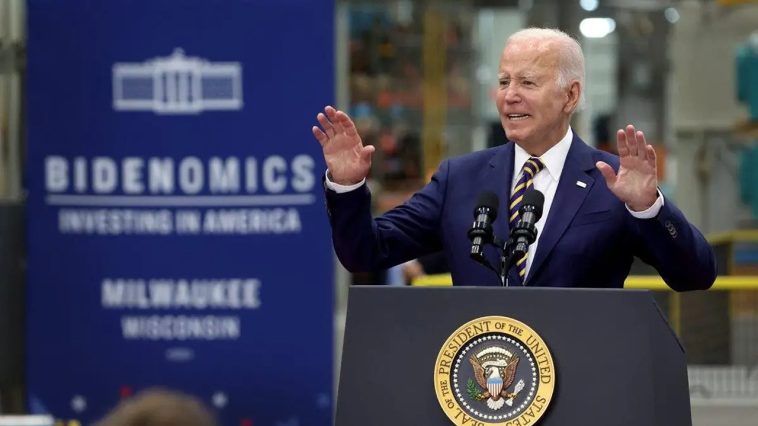LISTEN HERE:
As the federal administration continues to promote the financial state produced under its own policies, the catalyzing economic approach often called ‘Bidenomics,’ a recent report is bound to offer substantial talking points for the opposition leading up to the impending election cycle.
An insightful survey disclosed that, as of November 2023, a staggering 62% of consumers were dependent on their forthcoming paycheck for their monthly fiscal needs, according to the data collected by PYMNTS and LendingClub.
It was also noted that this precise set of consumers are the owners of nearly 60% of the credit cards circulating within the U.S. market. In an even more surprising twist, a vast 80% of these consumers who live paycheck-to-paycheck holds on average no less than two credit cards, as reported by Fox Business.
The informative report went on to highlight that those struggling with paycheck-to-paycheck patterns often carry a higher likelihood, almost twice as much as others, to extend their credit card balance into the consequent month.
Adding to the complexity, nearly a third of these consumers stated having hit their credit card limit, calculated to be an average of $9,200, sporadically within the past year as reported by the same outlet, referencing the analyzed data. As if this wasn’t concerning enough, the credit card debt has climbed an additional $48 billion during 2023’s third quarter, bringing the total liability to an unnerving $1.08 trillion as per the analysis by the Federal Reserve Bank of New York.
Although the current administration led by President Biden continues to defend its economic strategy, emphasizing that these policies have improved American livelihoods, real sentiments conveyed to pollsters tell a somewhat different narrative.
It appears that many Americans are contending with these policies by curtailing their holiday expenditures this season and, in several instances, amping up their work hours or even taking up additional jobs merely to manage the holiday expenses. Insights from a new survey, conducted by Empower, reveal a more in-depth understanding of the situation.
According to Empower’s 2023 holiday spending report, a significant 74 percent of the 1,000 participants disclosed that inflation has pressed them to curtail their holiday expenditure this year. In addition, around 31 percent reported putting in extra work hours to afford their holiday splurge, stated a separate report by Fox Business.
The survey also disclosed that over a third (34%) of the participants are navigating their budgets towards saving rather than spending this holiday season. This extend to making cuts in non-essential areas such as gift-giving and dining out in order to maintain their financial balance, as relayed by Courtney Burrell, a representative of Empower, to Fox Business.
However, how individuals manage their holiday budget is largely dependent on their personal priorities. For instance, some could choose to assign a greater portion to travel in order to visit family members whom they get to see only during the festive season, trading-off decorations or social commitments. While this may be an intriguing strategy for some, it’s not the only approach being taken.
The report stated that about 37 percent of respondents are planning to spend less than $250 on gifting this year, while more than a tenth of the participants shared with Empower that their holiday budget exceeds $1,000. Despite this measured cautiousness, data does indicate that spending during the holiday season is still lively. Outlays over the Thanksgiving weekend have set records, and overall holiday spending is projected to follow suit.
This spending surge, however, comes as American consumers are saddled with unprecedented levels of credit card debt. Some financial experts are voicing concerns about a looming crisis as balances climb, and an increasing number of people find themselves stumbling over repayments – a concern exacerbated by the current high interest rates, as reported by Fox Business.
October brought an even more disconcerting bulletin for the federal administration, exposing a severe crisis of faith amongst the electorate when it came to the administration’s ability to navigate economic issues. Surprisingly, a mere 39 percent of voters in pivotal swing states— Wisconsin, Arizona, Georgia, and North Carolina—expressed confidence in the President’s economic acumen, as reported by RealClearPolitics.
Steve Cortes, the chairman and founder of the League of American Workers, offered further context in his column on RealClearPolitics’s website, stating that economic concerns were the primary cause behind 77 percent of surveyed voters believing that the nation was heading down the wrong path. Out of the minority segment that did express support for the President’s economic handling, only a slim 9 percent bestowed ‘strong approval’.
So, contrary to the narrative that media apologists and selective data may weave, it does appear that voters are very much attuned to their economic challenges. A majority seem to place the responsibility of their economic hardship squarely on the shoulders of the current administration and its allies. It’s clear that, to them, the macroeconomic figures and government messaging doesn’t always correlate with the economic realism they’re experiencing.
In spite of the optimistic dissemination various outlets may project using a small, contextually favorable selection of data points, it’s evident that most voters have a discerning understanding of their economic struggle. The report offers a window into the lived economic reality of many Americans, a narrative far removed from the rosy figures and verdicts the government would have people believe.
It is imperative to comprehend that the surveys, figures, and reports narrate a story integrating widespread financial panic, increased financial responsibility, and a discernible marginalization of discretionary spending. These elements are providing an accurate understanding of the broad economic landscape that Americans are navigating in these challenging times.
In short, although the federal administration prefers to showcase a picture of economic health and prosperity, many Americans see a markedly different reality. This reality has an underlying tone of financial struggle, increased credit card debt, scaled-back spending during holidays, and waterfalling confidence in the economic leadership of the current government. A reality which will likely influence the narrative of the impending elections.



